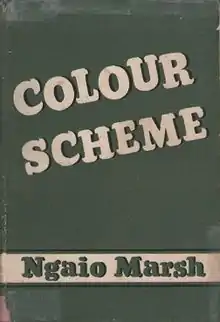Colour Scheme
Colour Scheme is a detective novel by Ngaio Marsh; it is the twelfth novel to feature Roderick Alleyn, and was first published in 1943. The novel takes place in New Zealand during World War II; the plot involves suspected espionage activity at a hot springs resort on the coast of New Zealand's Northland region and a gruesome murder whose solution exposes the spy. Alleyn himself is working for military intelligence in their counterespionage division. Marsh's next novel Died in the Wool also concerns Alleyn's counterespionage work in New Zealand.
 First UK edition | |
| Author | Ngaio Marsh |
|---|---|
| Language | English |
| Series | Roderick Alleyn |
| Genre | Detective fiction |
| Publisher | Collins Crime Club |
Publication date | 1943 |
| Media type | Print () |
| Preceded by | Death and the Dancing Footman |
| Followed by | Died in the Wool |
Background
According to her biographers Margaret Lewis [1]and Joanne Drayton,[2] for most of her adult life, Ngaio Marsh divided her time between her native New Zealand and travel abroad, with frequent and often prolonged periods spent in England, where most of her detective fiction is set. World War Two interrupted this pattern, obliging Ngaio Marsh to remain in New Zealand from April 1938 until June 1949, when she finally returned to England for another lengthy stay. During this ten-year period, Marsh lived with her elderly father on the outskirts of Christchurch, continued to write, drove a Red Cross transport vehicle and began her dedicated project to develop a professional theatre in New Zealand, working with students from Canterbury University, directing, producing and touring plays around the country. Again, according to her biographers, this had an inevitable and interesting effect on her detective fiction.
Marsh was commissioned by her publishers Collins to write one of their series of illustrated books for schools, The British Commonwealth In Pictures, and she travelled the country extensively while writing her contribution, New Zealand, published in 1942.[3] Since her 1938 return to New Zealand, four Roderick Alleyn mysteries had been written and published (Overture To Death, Death At The Bar, Surfeit Of Lampreys and Death And The Dancing Footman), all set in England. Now in 1942, Marsh decided to set her next two novels (Colour Scheme and Died In The Wool) in New Zealand, dispatching her series detective Roderick Alleyn there, to investigate wartime espionage. Although Marsh published two further New Zealand-set Alleyn mysteries (Vintage Murder 1937, Photo Finish 1980), the two wartime New Zealand novels stand distinctly apart from her main body of detective fiction.
Plot summary
In New Zealand's North Island, near the fictional coastal town of Harpoon and more remote than the actual spa resort of Rotorua, the thermal springs area of Wai-ata-tapu dominated by Rangi's Peak, an extinct volcano, is home to the Maori 'reservation' community, presided over by the distinguished senior Te Rarawa chief and former MP, Rua Te Kahu, and the failing neighbouring spa Hostel, incompetently run for the last 12 years by Colonel and Mrs Claire, retired Anglo-Indians, kindly, vaguely snobbish and shabby genteel. Also resident at the Wai-ata-tapu Hostel are the Claire's adult daughter Barbara and son Simon, Mrs Claire's brother Dr James Ackrington (an irascible, distinguished, retired medical consultant), Simon's 'cobber' Herbert Smith (an alcoholic 'remittance man' acting as general handyman) and Maurice Questing (a pushing businessman owed money by Colonel Claire and generally unpopular with everyone).
It is 1942, the advancing Japanese have bombed Darwin and recently sunk SS Hippolyte two miles out of Harpoon. Dr Ackrington writes to visiting CID espionage investigator Chief Inspector Roderick Alleyn voicing his suspicion that Questing is a spy. The other excitement is the arrival for a recuperative stay at Wai-ata-tapu of the illustrious English actor Geoffrey Gaunt, touring Australia and New Zealand, accompanied by his dresser-valet Alfred Colly and secretary Dikon Bell. The Hostel's maidservant-cook Huia is pursued by the half-caste Eru Saul; and finally an unexpected visitor, Mr Septimus Falls, arrives to treat his lumbago in the resort's mud pools and hot springs.
Everyone comes together at a concert put on by the Te Rarawa community in their village hall, in honour of Geoffrey Gaunt, at which several outbursts and confrontations occur, before the guests set out variously to return to the Hostel through the area of boiling mud pools and hot springs. Questing does not return and a horrific scream issuing from the thermal area suggests that the wretched man has fallen into Taupo-tapu, the huge boiling mud pool, where according to Maori legend a dishonoured Te Rarawa girl once met this fate with a similar, terrible shriek. This proves to be the case, and the local police investigation eventually reveals which of the suspects lured Questing into the mud-pool, and why: there as many motives as there are suspects. The investigation also identifies the spy whose signalling from Rangi's Peak has led to the enemy sinking of a second ship off Harpoon.
Astute readers will swiftly penetrate Chief Inspector Alleyn's incognito, but his identity is only revealed to the others in the final pages of the novel, as the solution is propounded.
Commentary
Television adaptation
Colour Scheme was one of four Alleyn novels adapted for New Zealand television in 1977; Alleyn was played by George Baker in a series called the Ngaio Marsh Theatre.[4]
References
- Lewis, Margaret (1991). Ngaio Marsh: A Life. Chatto & Windus Ltd. ISBN 07012 09852.
- Drayton, Joanne (2008). Ngaio Marsh: Her Life in Crime. Harper Collins. ISBN 978000 7328680.
- Marsh & Burden, Ngaio & R W (1942). New Zealand. London: Collins.
- Colour Scheme at IMDb